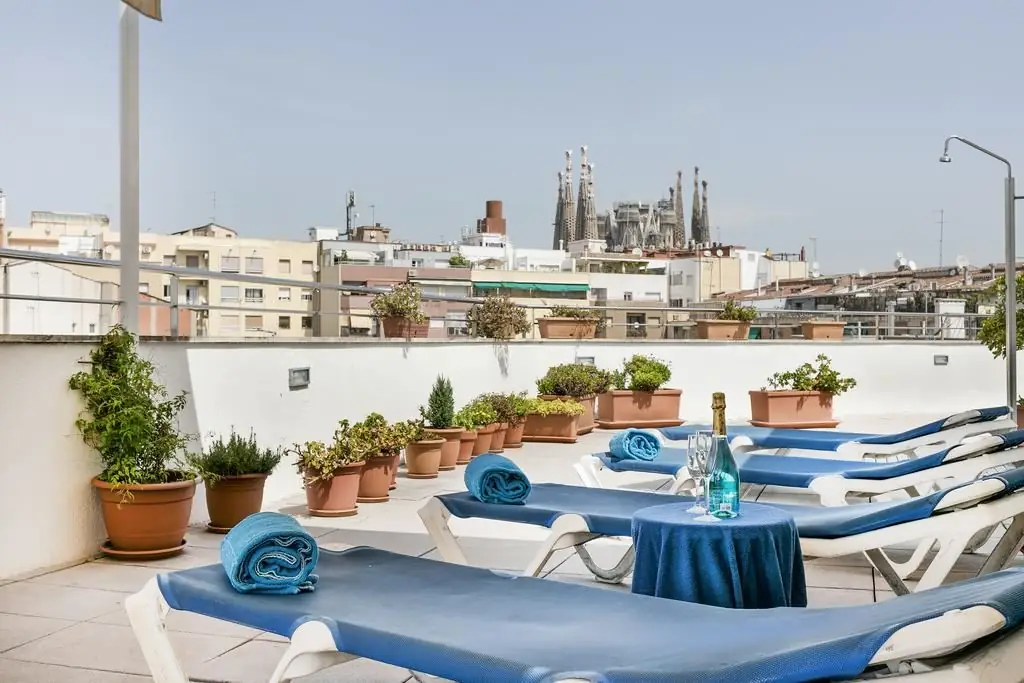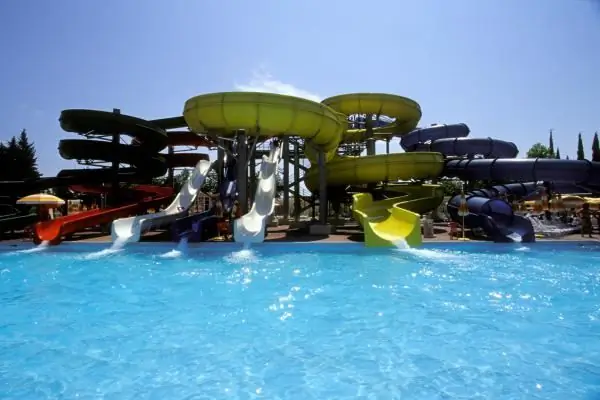- Author Harold Hamphrey [email protected].
- Public 2023-12-17 10:06.
- Last modified 2025-01-24 11:10.
Unlike other provincial capitals, Huelva in Spain is not as familiar to travel lovers. When you get here for the first time, you get the impression that you are in Victorian Britain. This is explained by the fact that in the 19th century the British actively developed mining enterprises here and at the same time built up the territory with structures in the architectural style popular at that time in England.
Nevertheless, centuries later, the city has not lost its charm - narrow streets, historical monuments, palm squares and a huge range of seafood offered in restaurants and bars. The city of Huelva in Spain is the smell of the sea wind and rosemary, it is the bright sun that sinks every evening into the ocean waters, it is an ancient city with a soul filled with Tarpeian, Greek, Phoenician, Roman and other cultures.

Wherethe city is located
The westernmost province of Andalusia is Huelva. Its coast - "the coast of the world" - starting from the mouth of the Guadiana River, stretches east, to the province of Cadiz. In the very center of the province, where the rivers Tinto and Odiel merge, not far from the ocean, is the capital of the same name - Huelva. This is a calm resort town with a population of about 150,000 people.

A bit of history
The history of Huelva in Spain is rooted in the distant past. The researchers found that more than five thousand years ago, a settlement already existed on these lands. The surrounding lands are rich in various natural resources. At different times they were inhabited by Greeks and Phoenicians, Muslims and ancient Romans. And today this territory keeps traces of these civilizations. For centuries, Huelva has been one of the most important port cities in the Pyrenees.
The city acquired special significance thanks to the journey of Christopher Columbus. The great navigator glorified both this town and all of Spain, brought her numerous overseas colonies that promised untold we alth. The devastating earthquake (1755), which occurred in nearby Lisbon, brought Huelva many troubles: countless evidence of a great cultural past was irretrievably lost. Only a few architectural monuments survived this catastrophe.

Since the 19th century, the era of active industrialization in the city began. Impressive foreign investments flowed into these regions, which attracted mineral deposits. At the end of the century bigBritish magnates contributed to the development of the city. Huge funds were directed to the development of the mining industry. The flow of foreign capital was followed by the construction of many outstanding structures. In addition, in 1889 it was here that the oldest, one of the first football teams in the country, Recreativo de Huelva, was founded.
Huelva (Spain): description of the city
This medium-sized (even by Spanish standards) city, which is located on an area of about 150 square meters. km, you will not be struck by the architectural chic inherent in Seville. You will not plunge into the vibrant life of nightlife here, as in Malaga. However, visit Huelva in Spain. The reviews of tourists indicate that stunning, charming landscapes await you on the coast of the Atlantic Ocean.
In this quiet town you will enjoy the atmosphere of complete peace. The city is located almost on the border with Spain, in the south of the country. It bears little resemblance to traditional Spanish towns in the region. Unlike many of them, where traces of Arab rule are visible throughout, Huelva is dominated by buildings in the English style. But this in no way affected the Spanish atmosphere reigning in Huelva: hospitable, friendly and smiling residents, incredibly tasty jamon, an abundance of sun leave no doubt that you are in Spain.

The old part of the city is small squares (the mayor of Koto Mora, for example) and narrow streets. Huelva has a quarter named after Queen Victoria. Hemade in classic English style.
The port of Huelva is bustling with life and has become the center of the fishing fleet. Next to it is Palm Boulevard, which is an oasis of silence, adjacent to a noisy port. In the vicinity of the city there are beautiful beaches with fine white sand, where tourists from Europe like to relax. They are offered exciting boat trips, diving, various types of surfing and sailing regattas, paragliding. Well-developed land and water infrastructure is suitable for a comfortable and pleasant stay.

Huelva is recognized as a culinary paradise, where gourmets are offered to taste delicious dishes from the freshest seafood. In this resort town, all vacationers will find entertainment to their liking: golf lovers, connoisseurs of historical and religious sights, and fans of extreme pastime, rock climbing for example.

Sights of Huelva: Cathedral
The main Roman Catholic church of Huelva in Spain, built in the early 17th century in the colonial style. Once it was part of the monastery. In the 17th century, the church was destroyed during several earthquakes. During the reconstruction, in 1775, it had to be almost completely restored. The reconstruction, which was led by the famous architect Pedro de Silva, dragged on and was not completed until the 40s of the last century. Another earthquake (1969) again destroyed the temple, and it was closed for another reconstruction.
With a magnificent pink façade and white marble interior, the building is recognized as one of the most striking examples of baroque architecture in the province of Huelva. It rises above the elegant and austere Plaza de la Merced. One of the main attractions of Huelva in Spain - La Merced Cathedral has baroque belfries that crown the bell towers. They were added to the temple only in 1915. The cathedral was built with three naves according to the plan of the basilica. The capitals of the columns with decorative Spanish Baroque and Mudéjar elements adorn the interior of the temple.

There is also a statue of the Virgin Mary, who is the patroness of the city. It was made by the sculptor Martinez Montañez at the beginning of the 17th century. The unique wood carvings and gilded decorations are admirable. Other valuable works of art kept in the cathedral include the painting "San Lorenzo" by Francisco de Viejo (1617) and the wooden pulpit (XVII). Huelva Cathedral was given the status of a national monument in 1970.
St. Peter's Church
The name of St. Peter in Huelva (Spain) is given to almost the whole area - St. Peter's Street, the square, the mountain, where the temple was erected, which became the first parish in the city. According to the established tradition, it was built on the foundation of a mosque that had previously been destroyed. Today, St. Peter's Church is still the city's main parish.
Saint Peter's Castle
The building is located in the historical center of the city, on the hill of the same name. It takes its name from the locationnear the Church of St. Peter. For a long time the castle was the architectural center of the city. But the Lisbon earthquake severely damaged it, and the castle fell into disrepair. Although it is a historical monument, funds for its reconstruction have not yet been allocated.
Huelva Museum
The exposition occupies a magnificent modern building located on Avenida Sandheim in the south of Huelva. It contains an interesting collection of artifacts. Among them you can see items from the dolmen complexes of El Pozuelo and La Sarsita, as well as the La Joya necropolis and the city of Tartessa. Artifacts of the era of the ancient Greeks and Phoenicians, discovered on the territory of the city during archaeological excavations, exhibits from the time of Muslim domination, are also stored here. All of them occupy three floors and a basement.

Exposition area is 3 thousand square meters. m, divided into two sections - fine arts and archaeological.
Columbus House
This is one of the most beautiful buildings in Huelva in Spain. You can see a photo of a luxurious historical monument in this article. Now, within the walls of the house of the legendary navigator, built in 1883, there is a hall for city events and press conferences, an exhibition hall. One wing of the building houses the residence of the Latin American Film Festival and the local archive.

Roman aqueduct
Thanks to the military campaigns of Julius Caesar, the southern coast of present-day Spain has become a colony of the Roman Empire. The Romans, who pursued an active policy of settlement andbuilding cities, used the settlement as the basis for construction.
A Roman aqueduct was built through the city in the 1st century BC. This structure until the 17th century provided it with water. It survived the raids of conquerors and earthquakes. Only the terrible Lisbon earthquake destroyed it in 1755. Thanks to the efforts and donations of the townspeople, in 1772 the water artery was restored. Some segments of the aqueduct functioned until the 20th century. True, by this time the water from it was used for technical purposes.
Outskirts of the city
The surroundings of Huelva also deserve the attention of tourists. They are definitely worth a visit. For example, the monastery of St. Clara, which is located 10 km from the city. It was founded in the 14th century. Surprisingly, his condition remained almost unchanged.
Of no less interest to tourists is the temple of the Virgin de la Cinta, which is located a few kilometers from the city, on Mount Conquero. The temple features the typical Andalusian Mudéjar style with baroque elements.

In this series of sights in the vicinity of Huelva, the Doñana National Park, which is under the protection of UNESCO, stands apart. It gained its fame due to the unique fauna and flora. The park can only be visited as part of excursion groups. Such excursions are most often organized from Huelva.
Palos de la Frontera, the port city from which Columbus set off on a journey in 1492 in search of the shores of America, is located a few kilometersfrom Huelva. The holiday associated with this date is one of the main ones in the city. Another attraction associated with this event is the active monastery of La Rabida (Huelva, Spain), where the navigator began to prepare for the journey, studied maps, carefully developed the route.
And in the east of the city there is a monument in honor of Christopher Columbus, donated to Spain by the authorities of North America. It was erected in 1929. It symbolizes the role of the province and the city in the development of the New World.
Reviews of tourists about Huelva in Spain
Many travel lovers who often visited Spain admit that they discovered this town by chance and were fascinated by it at first sight. They were delighted not only by the unusual architecture, numerous sights, picturesque nature, but also by the hospitality and cordiality of the townspeople.






